First World War Project
Sydney Arthur WATTS (of Lynsted)
b. 1895 Private, Service Number G/6289 |
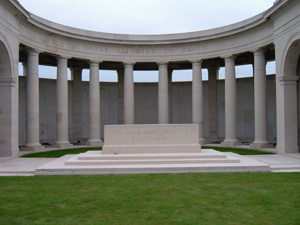
Sydney (sometimes incorrectly recorded as Sidney), was born at 54 Greenstreet, Lynsted, in 1895 to James, a self-employed plumber, painter and ironmonger, and mother Alice Maud (née Rickard). James was previously widowed on the death of his first wife Sarah Ann (née Palmer) with whom he had four children: Henry James, a plumber, painter and journeyman, Christiana Harriet, a parlourmaid, Florence May and Edgar Charles, a painter's apprentice. As well as these four elder half-siblings, Sydney had a younger full sister, Annie Maud Victoria. In addition, at the time of his death, Sydney had six step-siblings through the marriage of his widowed mother to Edwin Hadlow of Hernhill in 1913.
Sadly, on 8 June 1905 Sydney's father died. At the time of the 1911 Census his eldest step-brother, Henry, was now head of the household. Sydney was working as an apprentice shipwright. On 27 April 1913, Sydney's mother married Edwin Hadlow and, along with Sydney, moved to Uplands Farm, Dargate. Sydney now had six step-siblings through the marriage of his widowed mother to Edwin Hadlow. Alice May, Lilian, Sydney Herbert, Frederick Stanley, Clarence Edwin, Cyril Harold and Ivo Stuart.
At the time of Sydney's death he is recorded as serving in 1st Battalion, The Buffs. However, it appears that he started his active service with the 2nd Battalion, being the only battalion of The Buffs to see action in Salonika.
The service records for Sydney are not available, but we know that he enlisted in Faversham in June 1915, and, after a few months training, was posted to France on Tuesday, 5 October 1915. At this time the 2nd Battalion, The Buffs, was recovering from a hard experience at the Battle of Loos, where they suffered huge losses. Drafts arrived from England on 2, 3, 9, and 15 October to enable them to come back to full strength. Instructional parades commenced before the battalion returned to the trenches on 17 October.
Sydney's time in France was to be very short-lived. The Historical Records of The Buffs explains:
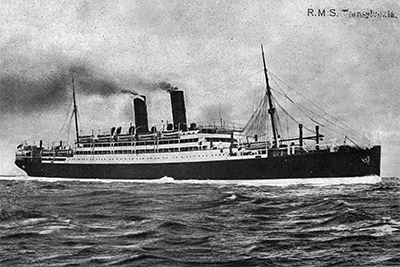 ……...on 21 October startling orders arrived: no less than instructions to entrain on the following day for Marseilles for conveyance to the East.
……...on 21 October startling orders arrived: no less than instructions to entrain on the following day for Marseilles for conveyance to the East.
No time was lost. On 22 the battalion marched to Fonquereuil, near Bethune, entrained there, arrived at the great port at 1.30pm on Sunday 24, and at 4pm embarked, complete with transport, animals, vehicles and all, on the troopship Transylvania for conveyance to Egypt. Twenty-seven officers and 907 other ranks reached Alexandria on 30 October and marched to Sidi Bishr Camp……………..The stay in Egypt was a very short one and was mostly devoted to training and marching. The whole of the 28th Division had moved and were to move again, for, one 22 November, came the orders for Salonika, the new base for operations against the Bulgarian forces.
| NOTE: On May 3 1917, the RMS Transylvania sailed from Marseilles to Alexandria with a full complement of troops, escorted by the Japanese destroyers Matsu and Sakaki. The following day it was struck in the port engine room by a torpedo fired by the German U-boat U-63 under the command of Otto Schultze. At the time the ship was about 2.5 miles (2.2 nmi; 4.0 km) south of Cape Vado near Savona, in the Gulf of Genoa. The Matsu came alongside the Transylvania and began to take on board troops while the Sakaki circled to force the submarine to remain submerged. Twenty minutes later a second torpedo was seen coming straight for the Matsu, which saved herself by going astern at full speed. The torpedo hit the Transylvania instead, which sank immediately. Ten crew members, 29 army officers and 373 soldiers lost their lives. |
However, Sydney would make it no further than Alexandria, as he contracted dysentery and was hospitalised there for three months. Following this he returned home for a further three months' convalescence.
By mid 1916, Sydney was fit to return to service. With his battalion still serving in Salonika, it is probable that it was at this time he was allocated to 1st Battalion, The Buffs, and sent to France. It is clear that Sydney's remaining service was hard, as he arrived back in service around the time of the start of the Battle of the Somme.
During July and August 1916, there were frequent reinforcements and new troops arriving from Britain, requiring the 1st Battalion to spend time in intense training in readiness for action at the Battle of Flers-Courcelette (15 - 22 September 1916), where they suffered more casualties than any other unit in the Brigade. Many men had been trapped in shell holes for hours before being able to make their way back to the line. Indeed, newspaper reports at the time of his death, make mention of how Sydney was trapped in no-mans-land for 48 hours before he could make it back to the lines. With little rest, the battalion's next encounter was the Battle of Morval (25 - 28 September 1916), which was considered "a glorious success" but with the loss of many men. On the second day of the battle, the battalion was relieved. The battalion was sadly depleted but an extract from a letter to Sir Courtenay Vyvyan (late of the Buffs) from the Acting Adjutant General of 6th Division reads:
"Your old battalion is going very strong. It is commanded by Green, and Gould is second in command. Otherwise from that I don't suppose you would know anyone. They did splendidly in the Somme and never lost their discipline for a moment. I saw them after the fight on 13th/18th September, when they only had 314 men left, and they might have been parading for the King's birthday. It really was a magnificent sight."
After time in the trenches near Givenchy, the battalion retired to Bethune and the trenches in that vicinity. Casualties were regular. On 20 December the battalion returned to Bethune, where Sydney would spend his last Christmas.
The first few months of 1917 saw few changes for the 1st Buffs. Locations changed but they still faced time in the trenches and suffered regular casualties. Not surprisingly there were frequent and long lists of medal awards and mentions in dispatches.
The beginning of April saw the battalion called into trenches near Loos and this is where they were for the opening of the Battle of Arras (9 April – 16 May 1917). Here again they suffered heavy casualties and received many battle honours. On 20 May the battalion retired to billets but were back in trenches near Loos just two days later.
During May and the beginning of June the battalion were in and out of trenches. On 11 June, there came a week of relative rest, except for Sydney's "D" Company, who were entrained to Allouagne to train for a raid, which would take place on 24 June. The attack would be on the enemy trenches in the Hulloch sector. The aim was "to obtain identification and inflict casualties, to capture prisoners, to destroy dug-outs and emplacements, and to draw the enemy's attention from other parts of the divisional front". The raid was successful, but again at huge cost.
The next few months saw the pattern of a few days rest followed by being in the trenches. The Battalion suffered frequent losses: indeed between the months of the battles of the Somme and Arras and Sydney's death, the 1st Battalion saw almost 500 men killed and scores wounded. Replacements came from raw recruits, men who had been "patched-up" or had previously been invalided out.
At the beginning of November 1917, the battalion gained some much needed and well earned rest. We know that at this time, after many months at the front, Sydney was able to take some home leave. Sadly this would be the last time. On his return to the Western Front, preparations were underway for the Battle of Cambrai.
Early November found the 1st Battalion at Beaudricourt, joining forces with 6th Battalion, The Buffs, and taking on a small trickle of only 10 other ranks. On 7 and 8 November, the Battalion marched to witness a tank demonstration. Six tanks took part and gave the Battalion some little idea as to the part planned for tank attacks in the forthcoming "Push".
Sydney's battalion war diary tells the story of his final days:
| Date | Operations |
| 11 November 1917 | Final of Brigade Sports. Battalion gained 2 firsts. |
| 13 November | Battalion Transport moved off on 4 days march towards Péronne. |
| 14 November | Increase 1 O.R. |
| 15 November | Battalion entrained for Péronne, Lt Blake and 3 O.R.s joined from Divisional Wing. |
| 16 November | Péronne: Battalion left Péronne and went into tents in Bois Dessart. |
| 17-18 November | Péronne: Battalion moved to forward area, and were attached to 3rd Corps. Increase 3 O.R.s. |
| 19 November | Péronne: Order of the day issued by Divisional Commander wishing all ranks success in the forthcoming attack. |
| 20 November | Villers Pluich: Battalion moved forward to attack at dawn co-operating with "B" Battalion tanks. The 1st Objective was the Blue Line (Main Hindenburg Line). 2nd Objective was the Brown Line (Support Hindenburg Line). The tanks advanced in line followed by the Battalion in Artillery formation and the 1st objective as soon taken. These operations were carried out and objectives taken with line the small loss of 8 O.R.s KILLED and 33 O.R.s Wounded. |
| 21 November | Trenches: Battalion consolidating 4 O.R.s wounded. |
| 22 November | Trenches: Battalion consolidating the line Nine Wood– Ascault– River, preparing for counter-attack, 2 O.R.s Wounded, 1 O.R. Died of Wounds. On this date Captain V.N. MOSS seeing that the village of Noyelles was lightly held by the enemy, collected a few men, with two tanks and attacked the village, capturing it including 14 prisoners, and liberated about 20 French civilians. Noyelles: Battalion defending Noyelles. |
| 23 November | Noyelles: Capt. A.F. Worster, M.C. Died of Wounds, the whole Battalion mourns for this officer. He was a universal favourite and had been with the Battalion 12 months and was awarded a bar to his Military Cross in June 1917. Lieutenants Harper and Clarke joined for duty. 10 O.R.'s Killed. |
| 24 November | Noyelles: Offensive ended, 1 O.R. Killed, 6 O.R.s Wounded. |
| 25 November | Noyelles: "B" Company defending Lock Bridge relieved by 87th Infantry Brigade, L.17.a.50.70. 1 O.R. Died of Wounds. |
| 26 November | Noyelles: 29th Division to capture enemy line at Mont Plaisir Farm. Battalion relieved and withdrawn to Hindenburg Line. L.27.a.70.10. to be in Divisional Reserve. Lt. Col. Green, D.S.O. left Battalion to Command 10th Infantry Brigade. Major B.L. Strauss assumed temporary command. |
| 27 November | Noyelles: Battalion moved to l.31.d.20.50.; 1 O.R. Killed. |
| 28-29 November | Noyelles: Situation unchanged. |
| 30 November | Noyelles: 6 O.R.s Wounded. |
| 31 November | Noyelles: 3 O.R. Reinforcements. |
| 1 December | Gouzeaucourt: The battalion reinforces the troops who were holding the line round Gonnelieu and La Vaquerie where the Hun broke through on the previous day. Killed: Major B.L. Strauss (C.O.; buried at SOREL) and7 Other Ranks; Died of Wounds: 1 O.R. Wounded: Capt. E.H. Allen (Adjutant); Captain J.R. Tibbles (R.A.M.C.); 2nd Lieut. P.R.T. Owen (L.G.O.);2nd Lieut. P.J. Fisher; 2nd Lieut. L.F. Clark; Lieut. G.B. Blake; C.S.M.P. Vincu of "C" Company & 45 O.R. Including 1 RAMC). When Major Straus was killed in 15 Ravine, Captain Allen took command of the battalion and Lt. R.M. Webster came up from Gouzeaucourt and took over the A/Adjutancy, Captain Pill (RAMC) Medical Officer of the 8th Bedfordshire came up and took over temporarily Medical Officer duties for us. In the evening the battalion were relieved and withdrew to Deadman's Corner and Captain Allen went to the dressing station and Major Hardy of the 2nd York & Lancasters temporarily took command of the battalion. The battalion remained at Deadman's Corner for about 2 hours and then moved back into the main Hindenburg system. |
| 2 December | Gouzeaucourt: Killed: 1 O.R. (attached 16th Infantry Brigade); Wounded: 1 O.R.; Died of Wounds: 1 O.R.; Missing: 3 O.R. (since reduced to one). |
It appears that Sydney was the "other rank" still accounted for as "missing".
| Faversham and North East Kent News of 19th January 1918 |
| Pte. Sidney Watts, the Buffs, youngest son of Mrs. Hadlow, of Hernhill (formerly of Greenstreet), and a brother of Mr. Harry Watts, of Greenstreet, is reported missing. |
Two weeks later the newspaper reported the sad news confirming Sydney's death:
| Faversham and North East Kent News of 9th February 1918 |
ROLL OF HONOUR Private Sydney Arthur Watts, The Buffs, who we recently mentioned as "missing," has since been reported killed in action on or about December 2nd. He was a son of Mrs. Edwin Hadlow, of Uplands Farm, Dargate, and a brother of Mr. Harry Watts, of Greenstreet. Deceased had been serving for two and a half years. After a few months' training he proceeded to France but had not been there long – though long enough to get into the firing line before he was drafted to Egypt en route for Salonika. In Egypt, however, he contracted dysentery and was for three months in hospital at Alexandria. Then he came home and was convalescing in England for three months, at the end of which time he again went to France, where he was in some of the severest of the Somme fighting. On one occasion he had an exceedingly trying experience, for following a heavy engagement he was lying for forty eight hours in No Man's Land before he was able to get back to the line. In November he came home on leave after a spell of seventeen months at the front, and it was shortly after his return that he was killed. Pte. Watts was 23 years of age and was well known in Greenstreet where the greater part of his life had been spent. |
The following week a service held at Hernhill Church in remembrance of Sydney was reported:
| Faversham and North East Kent News of 23rd February 1918 |
| A deeply impressive service was held in Hernhill Church on Sunday afternoon, the 9th inst., in memory of the late Private Sydney A. Watts. The Rev. Alfred Clark, in the course of his address, based on the words "A good solider of Jesus Christ," noted how quickly the gallant young soldier had won the high regard of all who knew him, and had given a bright example of a young soldier who had shown himself a good son, a true comrade, a ready volunteer when his country needed him, and a good soldier of Jesus Christ. Handel's Dead March "Saul" was beautifully played by Miss Foreman at the conclusion of the service. |
| In addition to the Lynsted memorial, Sydney is remembered on the War Memorial at St. Michael's Church, Hernhill. | |
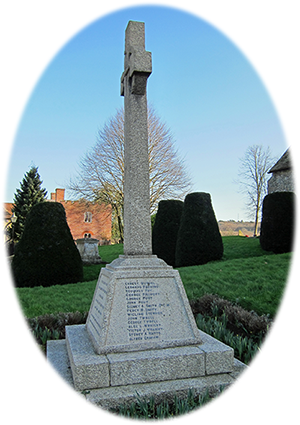 |
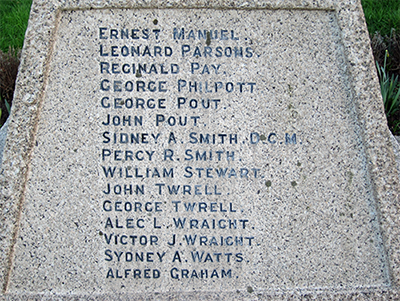 |
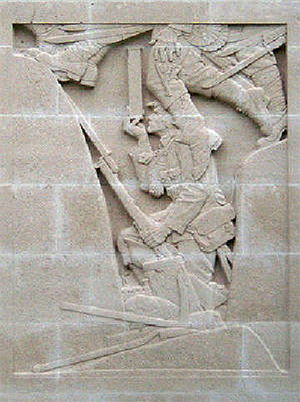 |
Also on the Cambrai Memorial, Louverval, Nord, France, where his name appears on Panel 3. The Cambrai Memorial commemorates more than 7,000 servicemen of the United Kingdom and South Africa who died in the Battle of Cambrai in November and December 1917 and whose graves are not known.
To the Glory of God and to the enduring |
Sydney was posthumously awarded 1915 Star, and the British War and Victory Medals. [See Appendix 1]
In April 1918, Sydney's mother received his money owed amounting to £9 17s 10d (£9.89p). In November 1919 she also received his War Gratuity of £11 10s (£11.50p). [See Appendix 2] Taken together these amount to roughly £1,200 in today's money.
Sydney was remembered by his family on the first anniversary of his death.
| East Kent Gazette of 6th December 1919 |
IN MEMORIAM WATTS: In loving memory of my loving son, Private Sydney Arthur Watts, who was killed in action, December 1st [sic], 1917, at Cambrai, France.
WATTS: In loving memory of our dear Brother, Sydney Arthur Watts, who was killed on December 1st [sic], 1917. |

 World War 1 Pages
World War 1 Pages